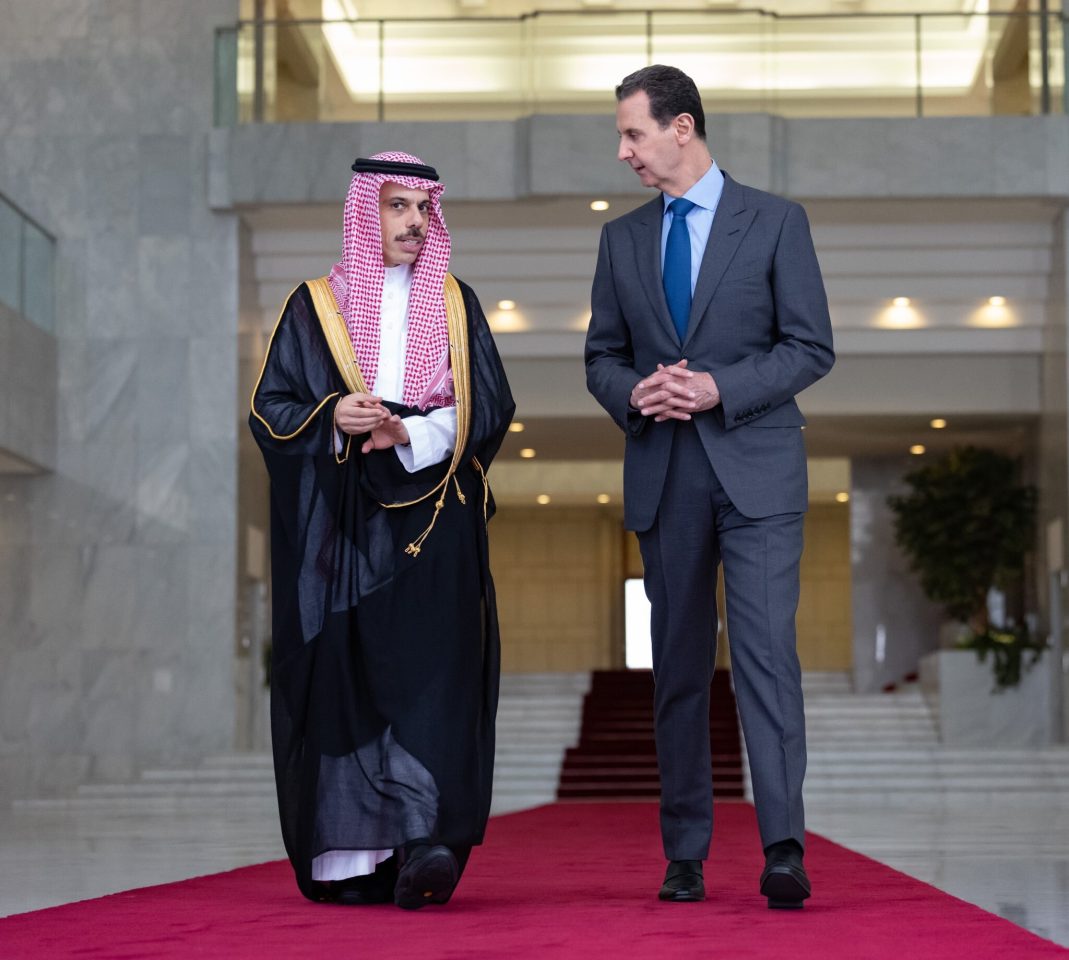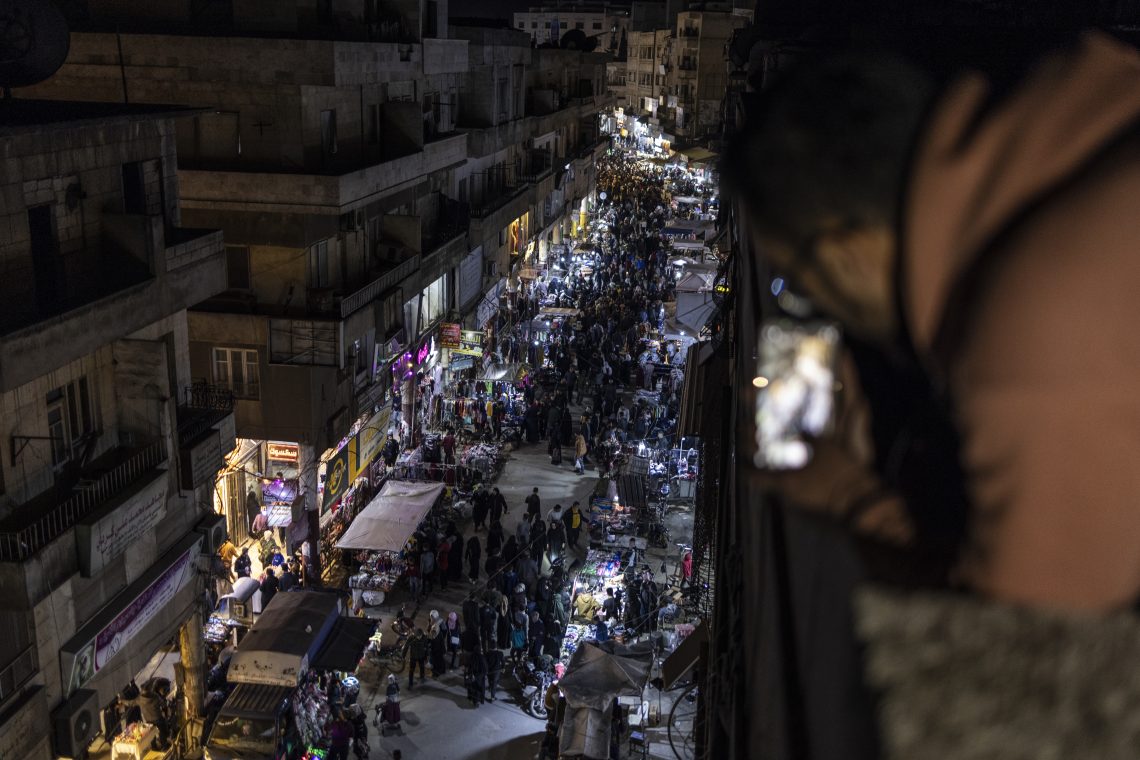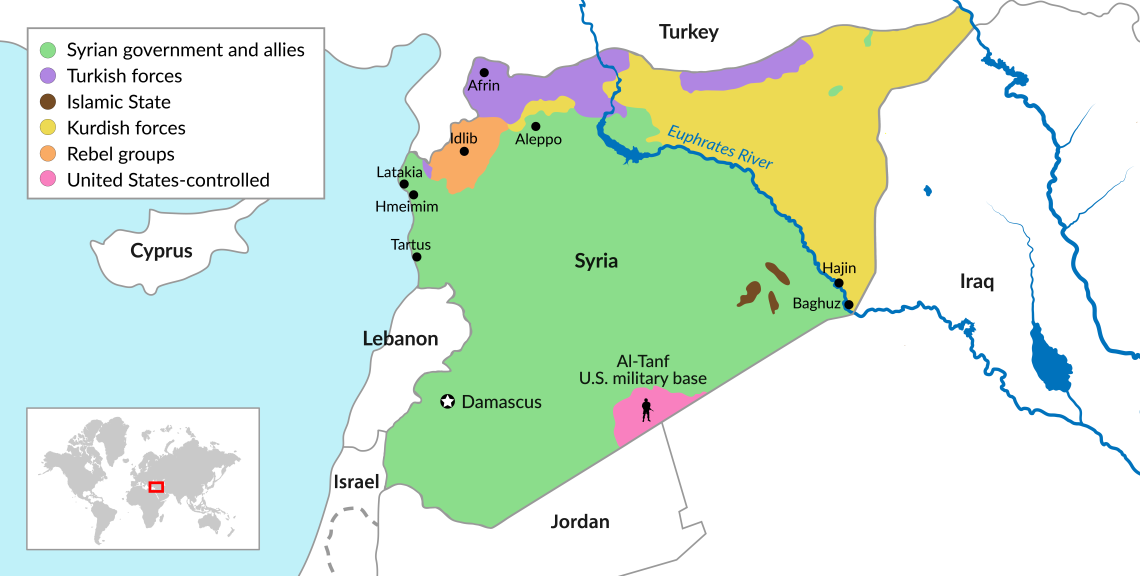Bringing Assad in from the cold
The end of Syrian President Bashar al-Assad’s diplomatic isolation is a recognition that opposition forces seeking to topple him have failed in the 12-year-old civil war.

In a nutshell
- Arab nations hope that ending Mr. Assad’s pariah status will restore stability
- Conflicts remain among Turkey, Kurds, Israel, Iran and the United States
- The status of Syria’s Idlib province and Syrian refugees is unresolved
The Syrian people are enduring extreme suffering while Bashar al-Assad’s regime thrives. Since the civil war began in 2011, over 500,000 Syrians have been killed and 12 million displaced, out of a prewar population of 21 million. The economic and social indicators are dire. Syria’s economy suffered an almost total collapse, leaving more than 90 percent of its people in poverty.
Electricity and fuel shortages, as well as rising food prices, are creating acute problems. Even in the capital of Damascus, the traditional lights of Ramadan were dim due to a lack of generators and fuel. Feasts to break the Ramadan fasting lacked meat for many impoverished families. Industry, transportation and government services have been brought to a near standstill. Safe drinking water is 64 percent of 2011 levels in urban areas and 38 percent in rural areas. Famine looms.
The northwestern province of Idlib is the hardest hit. It hosts over four million people, many of whom fled their homes since 2016. Many survive with little international aid. The devastating earthquake on February 6, 2023, near the Turkish-Syria border caused widespread destruction, with 45,968 deaths in Turkey and 7,259 in Syria. Over 10,300 buildings in Syria were destroyed or damaged, with losses of up to $8 billion.
In the autonomous Idlib area, over a million refugees living in tents were spared from being buried under rubble but endured a harsh winter due to damaged infrastructure. The Assad regime prevented humanitarian aid from reaching the affected areas except through regime-controlled airports, resulting in the looting of supplies by regime troops and militias. Only by March were some avenues for aid opened from Turkey.
Russia rescues Assad in 2015
In March 2011, most Arab countries broke off diplomatic relations with President Assad due to his massacres, his close relations with Iran and sectarian differences. The Arab League suspended Syria’s membership and imposed economic sanctions. Sunni-majority Arab states, some Gulf states and Recep Tayyip Erdogan’s Turkey supported the Syrian insurgents.
In 2015, Mr. Assad’s military was crumbling rapidly, despite Iranian and Hezbollah support. However, in September 2015, Iranian General Qassem Soleimani convinced Russian President Vladimir Putin to send Russian troops to save the Syrian leader, and since then Mr. Assad has gradually regained control over lost territories, now holding more than 60 percent of Syria.
Read more on Syria
Syria’s Assad is an unlikely survivor
Assad loses his pariah status
In 2016, the United Arab Emirates attempted to resume diplomatic relations with Syria but was dissuaded by the United States. However, in December 2018, the UAE opened its embassy in Damascus, indicating that they believed Mr. Assad’s recovery is irreversible.
The Gulf Arabs, particularly Saudi Arabia, historically acted as a stabilizing force in the Arab world, but in 2011 they supported revolutionary movements against Mr. Assad, hoping to gain influence after his fall. With these hopes dashed, they returned to their traditional approach of maintaining stability. In recent years, several Arab states, including the UAE, Oman and Bahrain have reinstated diplomatic relations with Syria, and there are signs of growing Arab consensus that isolating Syria is unworkable.
The recent earthquake in Turkey and Syria, along with the Saudi-Iranian rapprochement, has further accelerated this trend. In February 2023, several high-level visits to Damascus from Arab countries were presented as “humanitarian,” but they may also indicate a desire to mend relations and create alliances for political and economic purposes.
Saudi Arabia invites Assad to Arab League meeting
On March 7, Saudi Foreign Minister Faisal bin Farhan Al Saud said engagement with Damascus could lead to Syria’s return to the Arab League. On March 19, President Assad visited the UAE with his wife Asma, and in February 2023, he visited Oman. On March 21, Kamal Kharazi, chairman of Iran’s Strategic Council for Foreign Relations, praised Saudi influence on the Islamic world while visiting Mr. Assad in Damascus. The move was seen as a continuation of the Saudi-Iranian agreement signed in Beijing on March 10.
On March 23, the Saudi Foreign Ministry reported talks with Syria on resuming mutual consular services as the first step toward resuming full diplomatic relations. On April 2, the Saudi foreign minister traveled to Damascus and handed Mr. Assad an official invitation to the Arab League summit in Riyadh on May 19. On April 13 the two countries announced their intention to resume fully-fledged diplomatic relations and commercial flights. Also on April 2, Egyptian Foreign Minister Sameh Shoukry hosted his Syrian counterpart in Cairo, the first such visit since the 2011 civil war; and on April 3, President Kais Saied of Tunisia prepared to send an ambassador to Damascus.
Mr. Assad’s great achievement is that all these Arab conciliatory steps are taking place without any policy change commitment on his part. Very few Arab states remain opposed to Syria’s return to the Arab fold. On May 8, the Arab League decided officially to reintegrate Syria. Qatar was among the states that objected, so the decision was not put to a vote. Full diplomatic relations and normalization, however, were left to each individual state.

Biden administration softens its stance
Even U.S. President Joe Biden’s administration is retreating from its hardline anti-Assad policy. In February, following the earthquake, it suspended for 180 days the Caesar Act, the 2019 law that sanctions Mr. Assad and the Syrian government for war crimes against the Syrian people. On March 9, U.S. Assistant Secretary of State for Near Eastern Affairs Barbara Leaf outlined the administration’s views in an interview with the Al-Monitor news website, stating that Arab engagement with the regime should yield results. This message was reiterated in later interviews, although with an emphasis on continuity in U.S. policy and sanctions on the Syrian regime.
The U.S. expectation to get something for Arab states supporting President Assad’s return to the Arab fold became clearer in late March, when new sanctions were issued against individuals involved in the production and export of Captagon, a powerful amphetamine that is a major source of revenue for the Syrian regime. The sanctions target individuals associated with President Assad, including Khalid Qaddur and Samir Kamal al-Assad, involved in smuggling Captagon to Jordan and exporting through the Port of Latakia. The Biden administration wants Arab states to pressure Mr. Assad to stop this production and export, but this expectation may be unrealistic due to the high demand for the drug in Jordan and the Gulf states, and the dependence of Damascus on it for revenue. Democratic reforms are even less likely.
Some analysts hope that by again embracing Mr. Assad, he could be weaned from Iran. But this is a mistake. The Syrian leader is heavily dependent on Iran and the Tehran-backed Hezbollah for military support, especially with Russia tied down in Ukraine and growing popular resentment of his regime at home. Mr. Assad will not ask pro-Iranian militias to leave Syria, nor will he prevent Iran from establishing military bases and expanding its influence in Damascus and eastern Syria, including by supporting Hezbollah in Lebanon.
The desire for regional stability prevails
So why are the Arab states keen on reintegrating Mr. Assad’s regime? The Arab world is closely-knit historically, and events in one Arab country often reverberate throughout the region. The Gulf Arabs, led by Saudi Arabia, have traditionally acted as a stabilizing force in the region, preventing revolutionary changes and instability. In 2011, the Saudis ostracized Mr. Assad due to his atrocities against Sunni Arabs and their assessment that he would not survive the revolt. They even supported some of the revolutionaries, but he survived. Now, however, they returned to their traditional approach of maintaining stability.
The Yemen civil war poses a significant threat to the Gulf Arab economies, with Iranian-made and Houthi-launched missiles and drones targeting strategic assets in UAE and Saudi Arabia. Efforts to defeat the Houthi forces, too, have failed. The reconciliation with Syria and the Houthis of Yemen is part of a larger strategy: the Chinese-moderated Saudi-Iranian rapprochement. On April 9, Saudi and Omani delegations held talks with Houthi officials in Sanaa, Yemen’s capital. On April 15 the two exchanged prisoners of war. Oman has been an effective mediator now as in the past, even between Iran and the U.S. under former President Barack Obama. Additionally, Gulf Arab states may hope for lucrative reconstruction opportunities in Syria after years of devastation.
Jordan is concerned about Captagon smuggling and instability on its border with Syria and wants to repatriate the 675,000 Syrian refugees. Amman is also seeking an understanding with Hezbollah regarding the militant group’s presence in southern Syria. Resuming diplomatic relations with Syria and even a rapprochement with Iran may help.
Beyond the Egyptian need to close ranks with the Gulf Arabs due to its dependence on their economic support, Egypt has additional reasons for a rapprochement with Syria. Egypt sees an opportunity to align with Mr. Assad against the Muslim Brotherhood and limit Turkey’s influence. Despite Cairo’s reconciliation with Ankara and attempts at resolving differences between Ankara and Damascus, a Cairo-Damascus alliance may still be necessary. Egypt is also concerned about the far-right government in Israel and sees rapprochement with Syria as a reminder to Israel to behave. Arab countries normalizing relations with Syria represent the first step toward normalizing relations with Iran, similar to what Saudi Arabia is doing.
Many Arab states may maintain relations with both Iran and Syria, as well as with Israel and the U.S. Israel has conducted multiple attacks on Iranian and Hezbollah targets in Syria, indicating increased Iranian activities in Syria following the partial Russian withdrawal. While Israel has slowed Iran’s activities, its military campaign is risky due to potential retaliation from Syria and Iran. Iran has responded with drone attacks on Israeli-owned ships mainly in the Strait of Hormuz and terrorist attacks in Europe. There were also late-March drone attacks on American bases in Syria.
The U.S. struck back against pro-Iran militias, but President Biden is cautious about further escalation. The U.S. has around 900 troops in northeast Syria, successfully fighting the Islamic State of Iraq and Syria and supporting Syrian Kurds against pro-Iranian militias, President Assad’s troops and the Turkish army. They also have a small force in Syria’s Al-Tanf base to prevent Iran from accessing convenient routes to Damascus and Beirut. The U.S. is not considering troop evacuation without guarantees of an agreement with Mr. Assad, possibly some autonomy for the Kurds. Russia could be a potential partner in preventing harm to the Kurds.
Facts & figures
With Iran and Russia’s help, Syrian dictator Bashar al-Assad survives

Russia seeks to end hostility between Turkey and Syria
Russia has been attempting to resolve the hostility between Turkey and Syria for several years. In 2011, diplomatic relations between the two countries were severed. However, on December 28, 2022, Moscow successfully hosted a meeting between the ministers of defense and heads of intelligence of both countries, marking the most senior political meeting since 2011. A recent two-day meeting in Moscow among Russian, Turkish, Iranian and Syrian diplomats laid the groundwork for a meeting of higher-ranking officials.
In 2011, when the insurgency against the secular regime in Damascus erupted, Mr. Erdogan was already the prime minister of Turkey and a powerful figure in Turkish politics. By 2014, he had become the all-powerful president of Turkey. His Islamist government supported the Sunni Islamist revolutionaries, including ISIS, but primarily focused on supporting the Muslim Brotherhood, Mr. Assad’s old domestic nemesis.
Historically, relations between Turkey and Syria have been tense since the disintegration of the Ottoman Empire in 1918 due to territorial disputes and ideological differences between Turkish and Arab nationalism. Since 2011, the secular, Arab Alawite-hegemonic regime in Syria has been seen as anathema to the Islamic regime in Ankara. Additionally, Ankara has accused Damascus of supporting the Kurdistan Workers’ Party, the Kurdish-armed opposition in eastern Turkey.
Scenarios
Arab rapprochement with Syria will be almost complete in May. But the development will not tear Mr. Assad away from Iran, nor can it force the regime to accept democratic reforms. Small-scale voluntary return of refugees is to be expected, especially from the areas in Idlib that were badly hit by the earthquake. Yet, the voluntary mass repatriation of hundreds of thousands, let alone millions cannot happen without Arab or international safety guarantees that are lacking. Lebanon has begun to deport Syrian refugees, but they are reportedly facing conscription or arrest. Reconstruction, too, will be very limited as long as the U.S. is not rescinding the sanctions envisioned in the Caesar Act, and there is no hint yet that the U.S. intends to do so.
There are currently two main areas of friction between Turkey and Syria. Resolving them amicably could represent a major step forward in regional peace and stability. Yet an early solution to both issues is unlikely.
One of them is the fate of Idlib, a de facto autonomous area in northwest Syria on the border with Turkey, controlled by anti-regime Islamist groups. Damascus is determined to conquer this zone and drive the surviving population north into Turkey. However, Turkey is unable to handle an influx of refugees that would double the number of Syrian refugees it already hosts.
Another problem is the growing hostility in Turkey toward Syrian refugees. Moreover, Turkey is seen as the guarantor of the lives and security of the people living in Idlib. Betraying them would damage Mr. Erdogan's reputation. Russia, for its part, wants to see Idlib occupied by President Assad, but is concerned about the potential for a massacre and ethnic cleansing on its watch, and so close to its naval and air bases on the Syrian coast, as well as the possibility of Syrian-Turkish conflict.
In eastern Syria, as of April 2023, Turkey and its Sunni-Arab Syrian militias control approximately 50 percent of a stretch of land five to 20 kilometers deep along the mutual border. Turkey aims to establish a complete 30-kilometer buffer zone inside Syria to prevent military cooperation between Syrian and Turkish Kurdish armed groups, which Turkey views as terrorists. However, both Damascus and Moscow strongly oppose any Turkish occupation of Syrian territory, let alone its expansion. The territorial ambitions of Turkey along the border are also met with U.S. opposition. The small American force in northeast Syria provides crucial support to the Kurds, including air power and transportation.
The Americans view The People’s Defense Units, or YPD, the main military arm of the Syrian Kurds, as an ally in their fight against ISIS, and abandoning them to the Syrian government and Turkish assault would be seen as a betrayal by the international community. So, any meaningful expansion of Turkish control inside Syria is unlikely. In fact, with their effective drone technology today, Turkey can monitor a wide swath of the border zone and hit targets in Syria (and Iraq) without occupying it. At the same time, though, as long as Mr. Erdogan is not reaching a bold Oslo-type agreement with the armed Turkish Kurdish PKK, withdrawing from Syria will be very humiliating.
Mr. Assad, for his part, cannot accept any Turkish presence in Syria. This means that the status quo will remain, and any Assad-Erdogan agreement will be very limited. However, if Erdogan loses the May 2023 elections in Turkey, Turkish withdrawal from northern Syria is possible, as is a meaningful Turkish-Syrian rapprochement.
The surprise visit of Iran’s president to Damascus planned for early May, as well as the late April visit of Iran’s foreign minister to Lebanon, are sending two parallel messages. First, Iran must make it clear that the rapprochement between Syria (and next Lebanon) and the Arabs is not coming at its economic and strategic expense. Secondly, this is a hint to Israel that continued attacks on Iranian installations in Syria will become riskier from now on. The visit will certainly include a military component, but the economy is no less important. Iran has an excellent reason to fear that, in its reconstruction, Syria will prefer the high-quality Gulf and Turkish companies and products over the shoddy Iranian equivalents.
As a result of Iranian support and probably the internal Israeli crisis, Iran met with some success last March and April, when Israel was bombarded from four fronts: Syria, Lebanon, Gaza and the West Bank. Israel, though, cannot stop the aerial attacks. Tension therefore between Israel, on the one side, and Syria, Iran and Lebanon’s Hezbollah on the other, is likely to increase in the summer.










